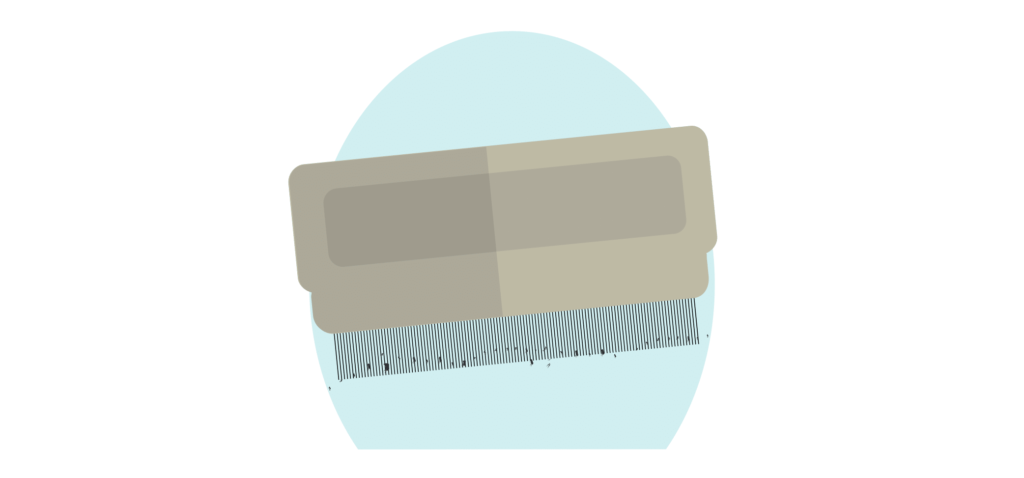If you suspect your dog has fleas it’s important to recognise the tell-tale signs of fleas and to assess the severity of the infestation in your dog’s environment and dealing with it as quickly as possible.
What are the signs your dog has fleas?
It’s a fact of doggy life that they scratch. After all, humans scratch from time to time, too. That means that not every scratching dog has fleas, and not every perfectly contented dog is completely free from fleas either.
However, because fleas survive by biting dogs and feeding off their blood, there are some key signs to look out for, including:
- Scratching or itching excessively
- Flea dirt
- Bites
How to identify and spot a flea bite
Flea bites can be spotted quite easily on a human’s skin since we don’t have as much hair covering us as our four-legged friends.
You’ll be able to identify the bites if you can see tiny red dots, smaller than other insect bites since fleas are very small themselves. The bites will often appear in clusters of three; this will occur sometimes if a flea is disturbed during feeding it will later return to a similar area and continue.
Once a flea has bitten a dog, the bite can take from five to 30 minutes to wheal (when the skin elevates). Usually, you won’t be able to see a puncture mark in the skin, since fleas are experts at causing minimal damage. Sometimes the bites will cause a rash and can cause secondary skin issues such as dermatitis.
If you suspect your dog has fleas there are a number of ways you can find out for sure. Your dog may not be happy about you carrying out some of these checks, but persevere; it’s for their own good!
What’s more, fleas are well adapted at scurrying away from prying eyes, fingers and combs – in fact, it’s what they’re best at! A more thorough inspection of your dog’s hair and skin will reveal whether or not fleas have been living on your dog.
Check your dog’s belly, armpits and ears
Make sure your dog is comfortable being handled, gently encourage them to roll on to their back (bonus points if you can get them to do this on command!). Now you should be able to carefully check their belly, and armpits for any sign of fleas. These are the warmest, shadiest and most protected areas of their bodies, these are the most likely spots that fleas may be hiding.
Use a flea comb

The best type of flea comb to use is one with fine teeth – check out a list of the ten best flea combs as reviewed by other dog owners which will help to remove small signs of fleas living in your dog’s hair. This will include fecal matter (sometimes known as flea dirt) which is actually dried, digested blood that fleas have passed – yes, it’s a disgusting thought.
Use the damp paper & flea comb technique to identify the presence of fleas
Useful for finding flea dirt, eggs and fleas themselves.
Flea dirt is the excrement and dried fecal matter that fleas leave behind. It will have a dark brown colour when dry but will turn red when it comes into contact with water.
Here’s how to use the wet paper method to find fleas on your dog:
- Ensure your dog is dry. If your dog has long or thick hair, you may find it helpful to brush their hair with a regular brush first to help remove any tangles. Dog breeds like Afghan Hounds, Springer Spaniels, Cocker Spaniels, Retrievers and Irish Setters in particular will benefit from this pre-comb brush.
- Place some white paper or newspaper on the floor – if you have a tiled or laminate floor that is easy to clean afterwards this would be ideal.
- Encourage your dog to stand or sit on the paper.
- Use a flea comb to brush your dog’s hair, starting at their neck and shoulders and work your way down towards the tail and back. Brush any dirt dead hair onto the paper. You may discover fleas during this process, but they are evasive!
- Sprinkle a little water onto the paper. If the dirt turns red that means that it’s very likely it contains blood and your dog has fleas.
What you need to know about flea dermatitis
Dermatitis can be a result of several underlying health problems, including food allergies, ear infections, mites and mange. Dermatitis is often referred to as a secondary condition, and so it’s important to consult your vet to find the root cause.
When a flea bites your dog, they excrete saliva to help them to locate a suitable site on the host’s skin for feeding. It’s actually the saliva, rather than the bite itself, that causes a dog to itch.
Dermatitis on dogs can be identified by the following symptoms:
- Intense itchiness
- Licking, biting or even chewing at their skin
- Secondary infections resulting from the aggravation of the skin
- Hair loss
- Hot spots or sores
- Bad smelling skin or ears
Itchiness is actually useful to fleas as it helps continue the flea life cycle; when a dog scratches they will dislodge flea dirt and eggs into the same spot in their environment. When the eggs hatch, the emerged larvae will have an immediate source of food – fleas are clever little devils!
If you suspect the cause to be fleas, you can check your dog using the methods we’ve listed above.
If you’ve found signs of fleas on your dog, you’ll want to kill those little nasties as quickly as you can. Read our tips on how to do this.